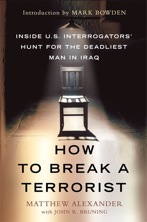
In the debate over using torture in interrogating detainees in Iraq and at Guantanamo, we’ve heard from a lot of armchair quarterbacks — pundits who have never interrogated anyone, but think they know which techniques would be most effective in eliciting information from a prisoner.
None of them has had the experience of Matthew Alexander, who was the chief US interrogator in Iraq, and who led the team that eventually brought down Abu Musab Al Zarqawi, the head of Al Qaeda in Iraq. How did Alexander and his colleagues do it? By using brains, not brutality. By building relationships, not beating people up.
In December, 2008, I spent an hour speaking with Alexander about his experience, which he recounted in his book, “How To Break A Terrorist.” He told me that torturing prisoners ended up costing American lives, as it served as the biggest recruiting point for Al Qaeda. We talked about his methods and results, despite resistance from the Pentagon (which fought the publication of his book), and why he so strongly disagreed with torture as an interrogation technique.
He explained how his team elicited information from adults (and children) who didn’t bother to contain their hatred for America, how his translators were helpful in explaining idioms peculiar to Iraqi culture, and how he managed to gather information from even the most hardened detainees.
This is not a guy in a think tank or a TV talking head. Alexander sat a foot away from terrorists and fanatics and won the mental battle time and again. He was awarded the Bronze Star for his work, which hopefully has influenced those who succeeded him.
